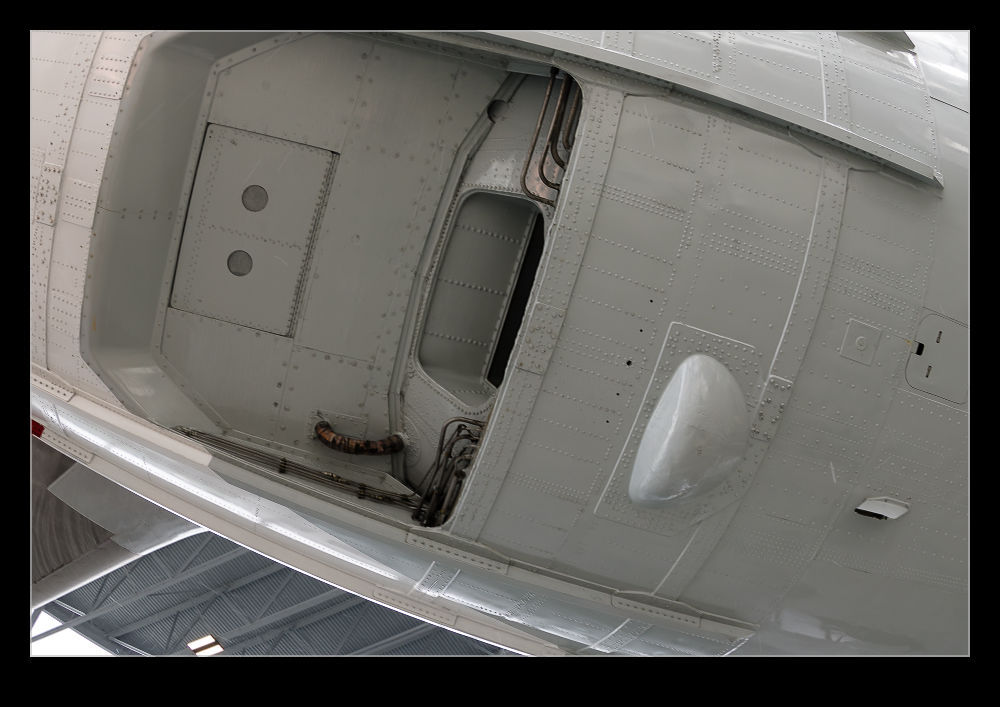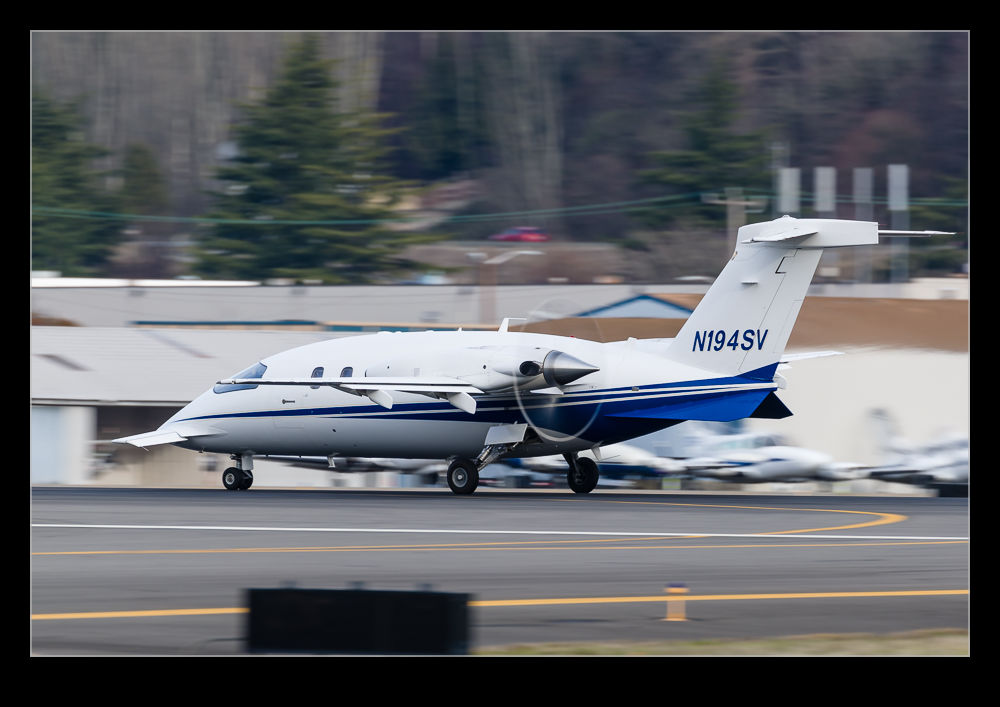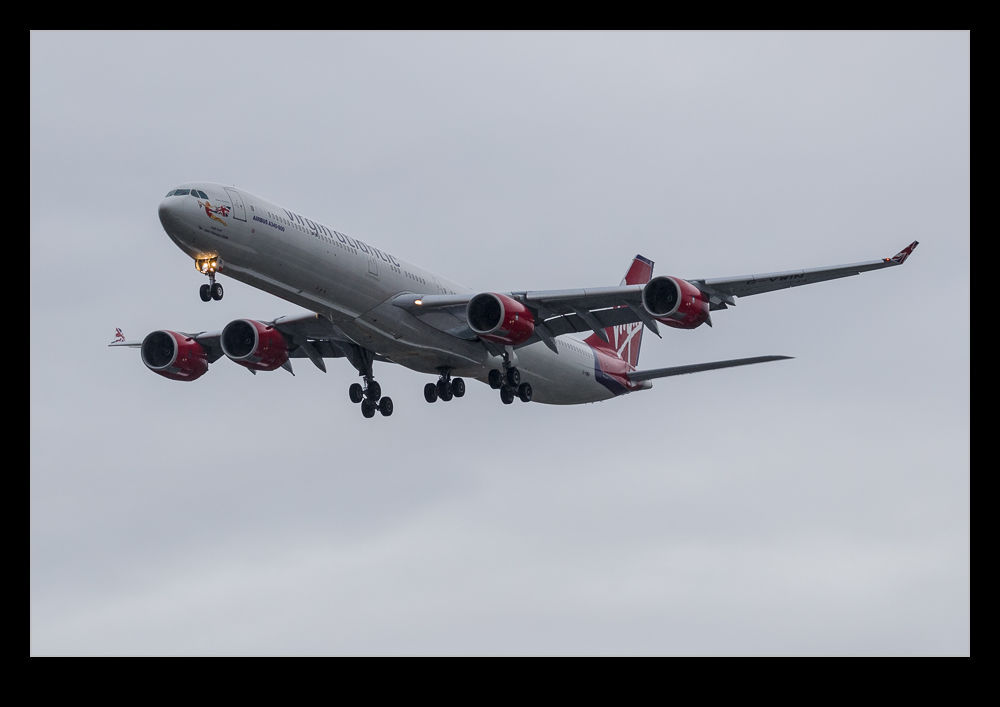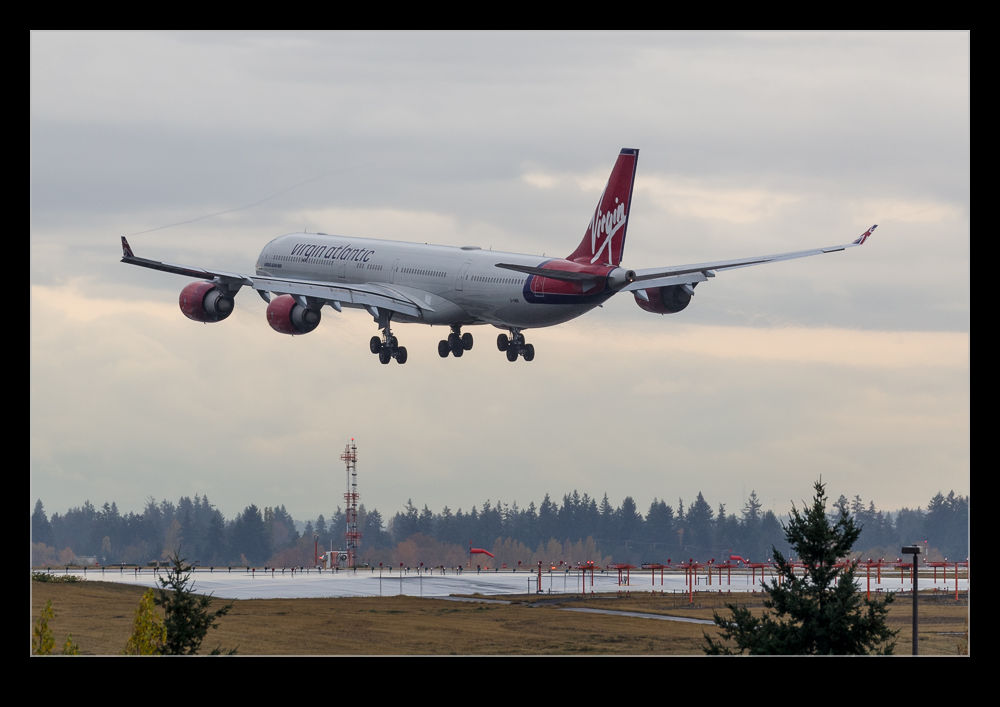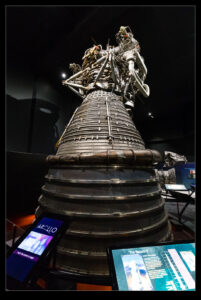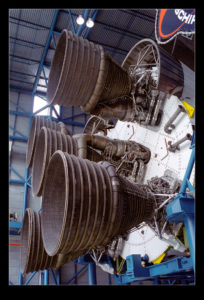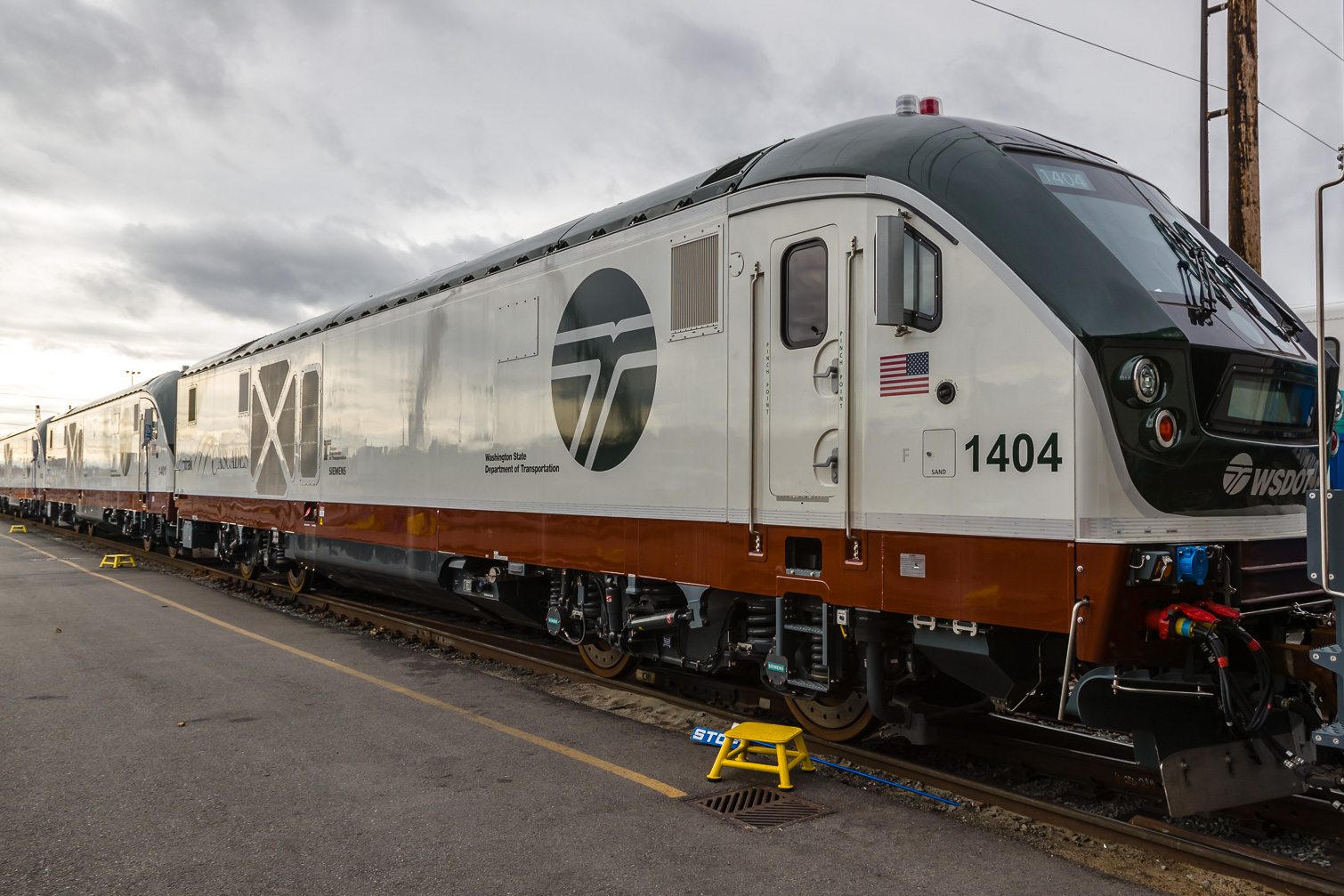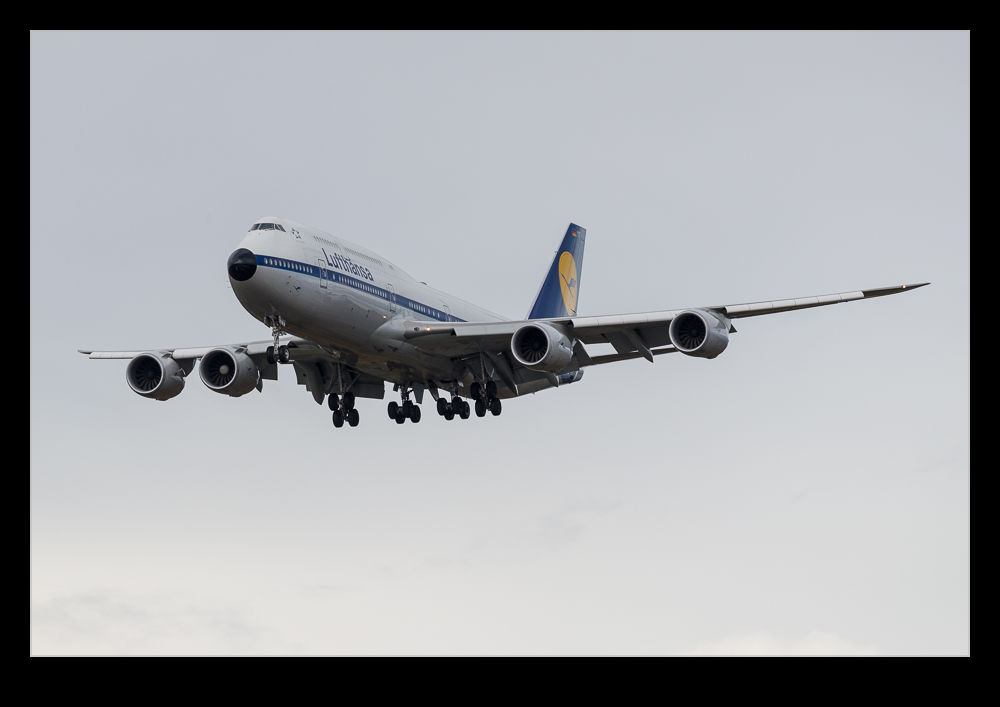 If you think of aerial refueling tankers, the Boeing 747 is not going to be the first plane that jumps to mind. However, a tanker version of the 747 was developed and is in service to this day in Iran. I haven’t seen one of those planes but, before they were built, Boeing undertook testing of the configuration on their testbed, the original 747 prototype. This is on display at the Museum of Flight in Seattle. When we were walking through the fuselage, we got to the read and found the boomer station. Apparently, it was not removed after installation. It looks remarkably similar to that from a KC-135 so I guess they ported the design across rather than come up with something significantly different.
If you think of aerial refueling tankers, the Boeing 747 is not going to be the first plane that jumps to mind. However, a tanker version of the 747 was developed and is in service to this day in Iran. I haven’t seen one of those planes but, before they were built, Boeing undertook testing of the configuration on their testbed, the original 747 prototype. This is on display at the Museum of Flight in Seattle. When we were walking through the fuselage, we got to the read and found the boomer station. Apparently, it was not removed after installation. It looks remarkably similar to that from a KC-135 so I guess they ported the design across rather than come up with something significantly different.
Tag Archives: seattle
Lake Washington Sunset
 Sometimes you are just in the wrong place when the conditions are right. We were driving across the floating bridge that takes SR520 between Seattle and Bellevue one evening. The sun was going down and the sky to the north was pink. The water of Lake Washington was smooth and was reflecting the sky beautifully. We were in a car doing 60mph so there was nothing to be done about it. Once across the bridge, I avoided the freeway and took Lake Washington Blvd towards home. It runs alongside the lake and, while a slower road, it is a shorter distance and a more pleasant drive.
Sometimes you are just in the wrong place when the conditions are right. We were driving across the floating bridge that takes SR520 between Seattle and Bellevue one evening. The sun was going down and the sky to the north was pink. The water of Lake Washington was smooth and was reflecting the sky beautifully. We were in a car doing 60mph so there was nothing to be done about it. Once across the bridge, I avoided the freeway and took Lake Washington Blvd towards home. It runs alongside the lake and, while a slower road, it is a shorter distance and a more pleasant drive.
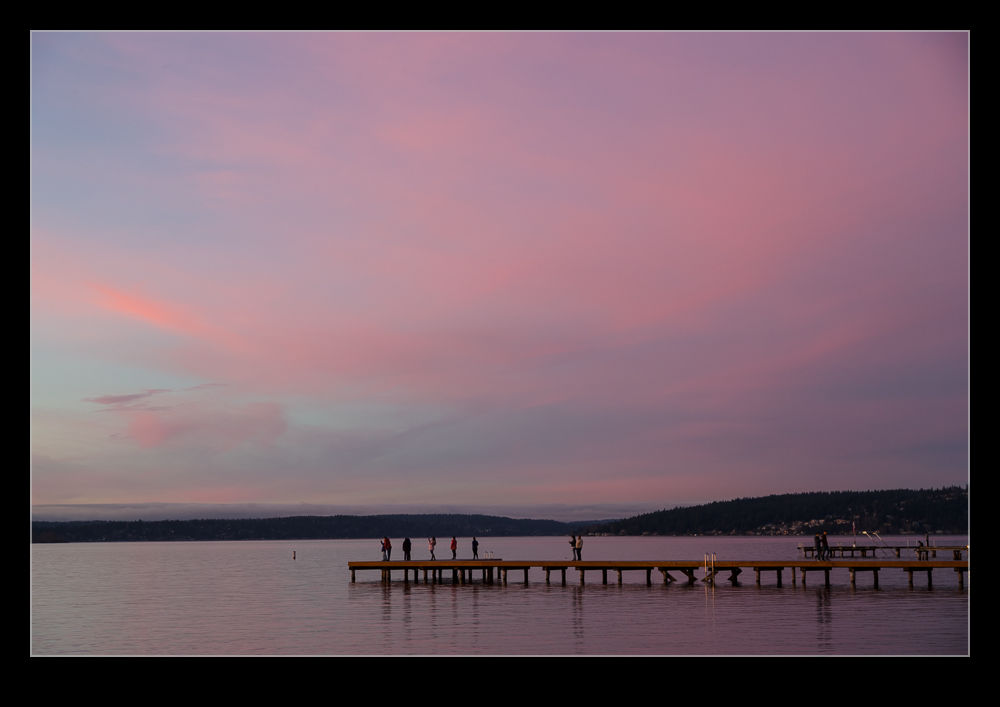 As we got alongside the water, the sky was still looking rather impressive. The pink to the north had faded but the sky to the west still looked great. There is a park along the shoreline and I zipped in there to see if I could find a parking spot. Sure enough, someone had just left so I hopped out and took a few shots before the whole thing was done. The orange in the sky towards downtown Seattle was very intense and it all looked great. I guess I got a second bite of the apple.
As we got alongside the water, the sky was still looking rather impressive. The pink to the north had faded but the sky to the west still looked great. There is a park along the shoreline and I zipped in there to see if I could find a parking spot. Sure enough, someone had just left so I hopped out and took a few shots before the whole thing was done. The orange in the sky towards downtown Seattle was very intense and it all looked great. I guess I got a second bite of the apple.
Trailing Static Cones
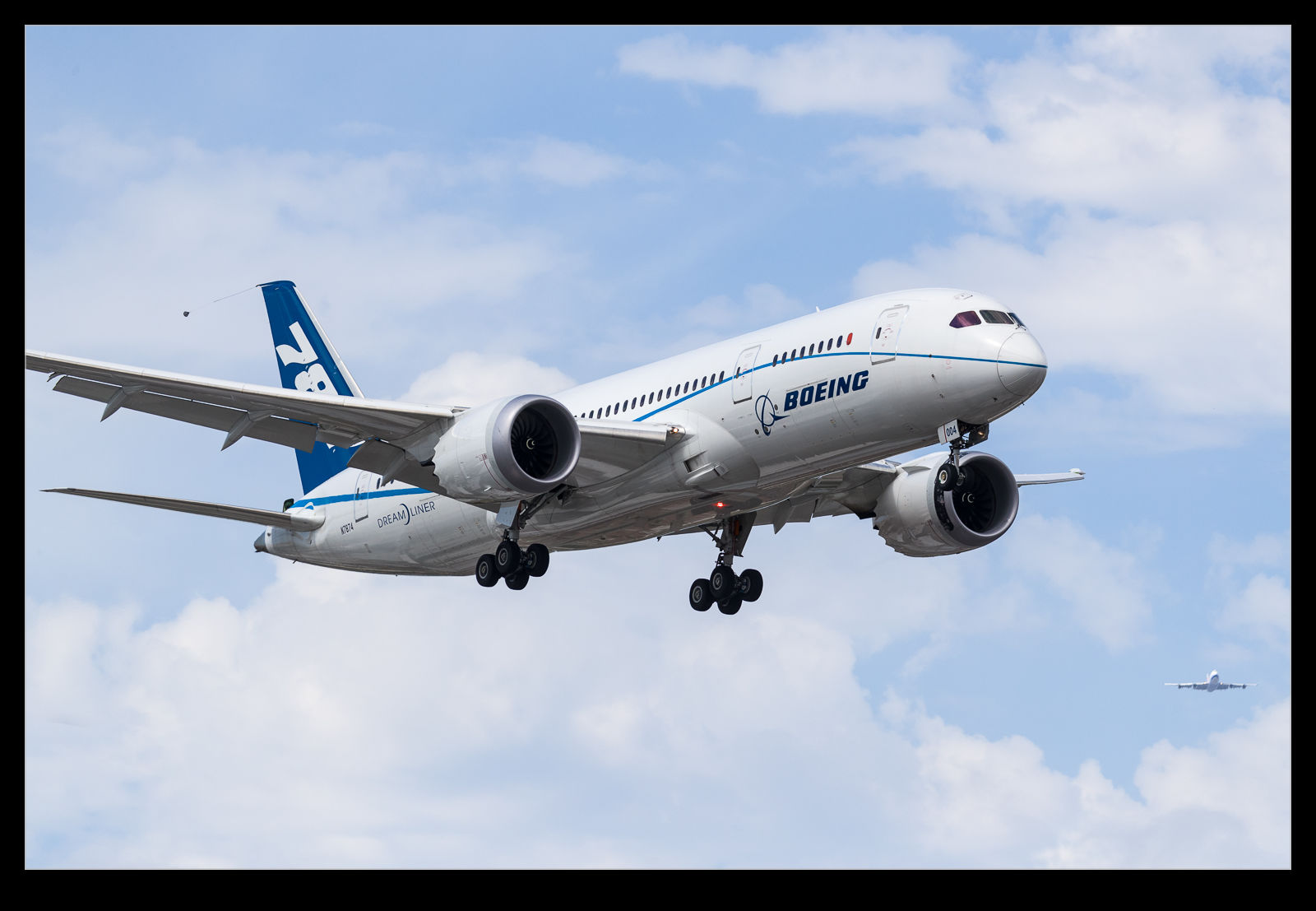 For the people that don’t care for my aviation posts, this one won’t be of interest. For the aviation fans that don’t care about the techie stuff, this will also be of limited interest. That probably leaves a very small group of readers by now (Gary, I am trusting you are still here). This is about a piece of flight test instrumentation that often causes questions when people see it. It is the trailing static cone.
For the people that don’t care for my aviation posts, this one won’t be of interest. For the aviation fans that don’t care about the techie stuff, this will also be of limited interest. That probably leaves a very small group of readers by now (Gary, I am trusting you are still here). This is about a piece of flight test instrumentation that often causes questions when people see it. It is the trailing static cone.
 The aircraft has sensors that measure air data, two of the most important of which are the pitot probe and the static port. The pitot probe measures the dynamic pressure of the air which increases as the speed increases. The static port measures the air around the aircraft. The difference between the two is used to determine the speed of the aircraft and the static is used to determine the altitude. These are both vital information for a pilot. However, the aircraft affects the flow of the air around it so, while you can calculate what the pressures should be, you need to validate what the actual readings are. The first flights are carried out prior to calibrating the system so you need to have a bit of margin in the speeds you use until you have confidence in the readings.
The aircraft has sensors that measure air data, two of the most important of which are the pitot probe and the static port. The pitot probe measures the dynamic pressure of the air which increases as the speed increases. The static port measures the air around the aircraft. The difference between the two is used to determine the speed of the aircraft and the static is used to determine the altitude. These are both vital information for a pilot. However, the aircraft affects the flow of the air around it so, while you can calculate what the pressures should be, you need to validate what the actual readings are. The first flights are carried out prior to calibrating the system so you need to have a bit of margin in the speeds you use until you have confidence in the readings.
 Measuring static pressure is hard to do. The plane will have a static port on the skin of the plane as well as possibly incorporated with the pitot head. However, the air has accelerated to go around the fuselage so it is assumed to have a lower pressure than ambient. Because the plane is disturbing the flow, you need a way to measure the pressure some distance away from the plane. The answer is a trailing static cone.
Measuring static pressure is hard to do. The plane will have a static port on the skin of the plane as well as possibly incorporated with the pitot head. However, the air has accelerated to go around the fuselage so it is assumed to have a lower pressure than ambient. Because the plane is disturbing the flow, you need a way to measure the pressure some distance away from the plane. The answer is a trailing static cone.
 This cone incorporates pressure measurement sensors and it attached to a long cable. This is held on a reel inside the aircraft and fed out of the aircraft at the rear. For airliners, this is usually through a modification to the top of the fin. A comparison between the test aircraft and a production jet will show the different structure. The cable dangles out of the fin and, as the speed increases, the cone pulls the cable taught and streams backwards.
This cone incorporates pressure measurement sensors and it attached to a long cable. This is held on a reel inside the aircraft and fed out of the aircraft at the rear. For airliners, this is usually through a modification to the top of the fin. A comparison between the test aircraft and a production jet will show the different structure. The cable dangles out of the fin and, as the speed increases, the cone pulls the cable taught and streams backwards.
 When the testing is required, the cable is winched out and the cone is a long way behind the aircraft in what is relatively undisturbed airflow. If you go to the Museum of Flight, the prototype 747 is on display and it includes the trailing cone equipment in the fuselage. The reel is shown in its mounting location and the trailing cone is hung inside to allow you to take a look at it.
When the testing is required, the cable is winched out and the cone is a long way behind the aircraft in what is relatively undisturbed airflow. If you go to the Museum of Flight, the prototype 747 is on display and it includes the trailing cone equipment in the fuselage. The reel is shown in its mounting location and the trailing cone is hung inside to allow you to take a look at it.
Two Avantis in One Go!
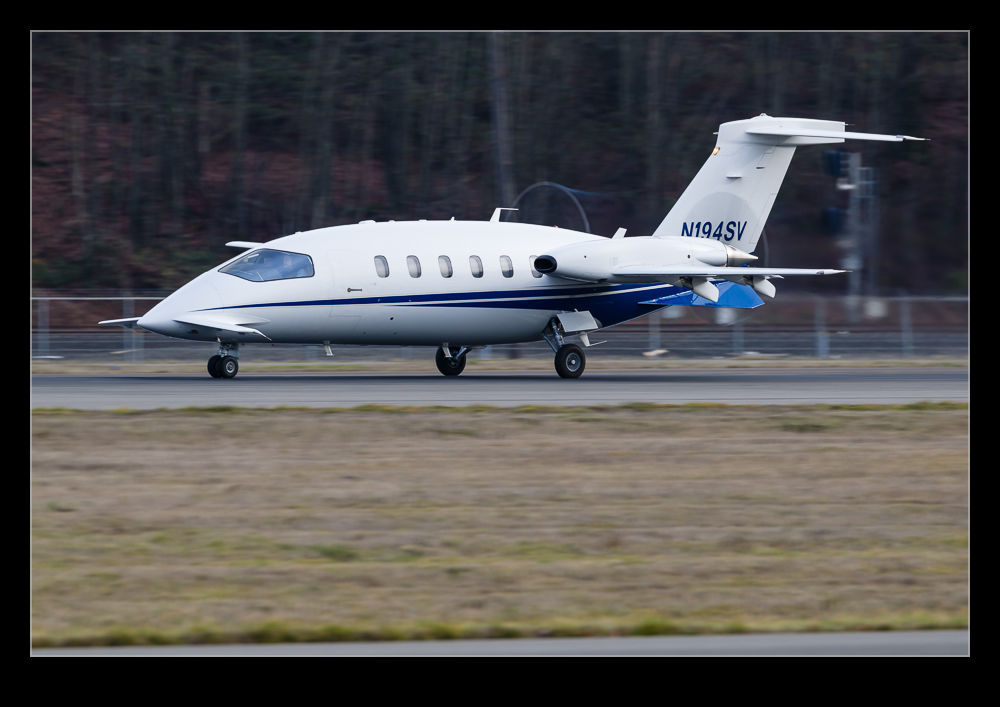 Not long ago, I posted about seeing an Avanti for the first time in a while. The lack of Avantis having been broken, I have seen a couple more. I saw that one had come in to Boeing Field and I was there before it fired up for its next flight. It taxied out on the opposite side of the field and then took off to the northeast.
Not long ago, I posted about seeing an Avanti for the first time in a while. The lack of Avantis having been broken, I have seen a couple more. I saw that one had come in to Boeing Field and I was there before it fired up for its next flight. It taxied out on the opposite side of the field and then took off to the northeast.
 A short while later, I saw a silhouette of a plane on approach and looked closer to see what it was. It looked pretty like an Avanti so I figured it was the same aircraft returning for some reason. I was a bit bothered that something might be wrong but happy to get another chance to shoot it. As it got closer thought, it was clearly not in the same paint scheme. Instead, it turned out to be a Canadian registered example and a pretty nice looking one at that.
A short while later, I saw a silhouette of a plane on approach and looked closer to see what it was. It looked pretty like an Avanti so I figured it was the same aircraft returning for some reason. I was a bit bothered that something might be wrong but happy to get another chance to shoot it. As it got closer thought, it was clearly not in the same paint scheme. Instead, it turned out to be a Canadian registered example and a pretty nice looking one at that.
 Getting two Avantis within a short space of time was an outcome I was pretty pleased with. Unfortunately, I couldn’t hang around to get the departure of the second example.
Getting two Avantis within a short space of time was an outcome I was pretty pleased with. Unfortunately, I couldn’t hang around to get the departure of the second example.
Sounder’s New Cab Cars
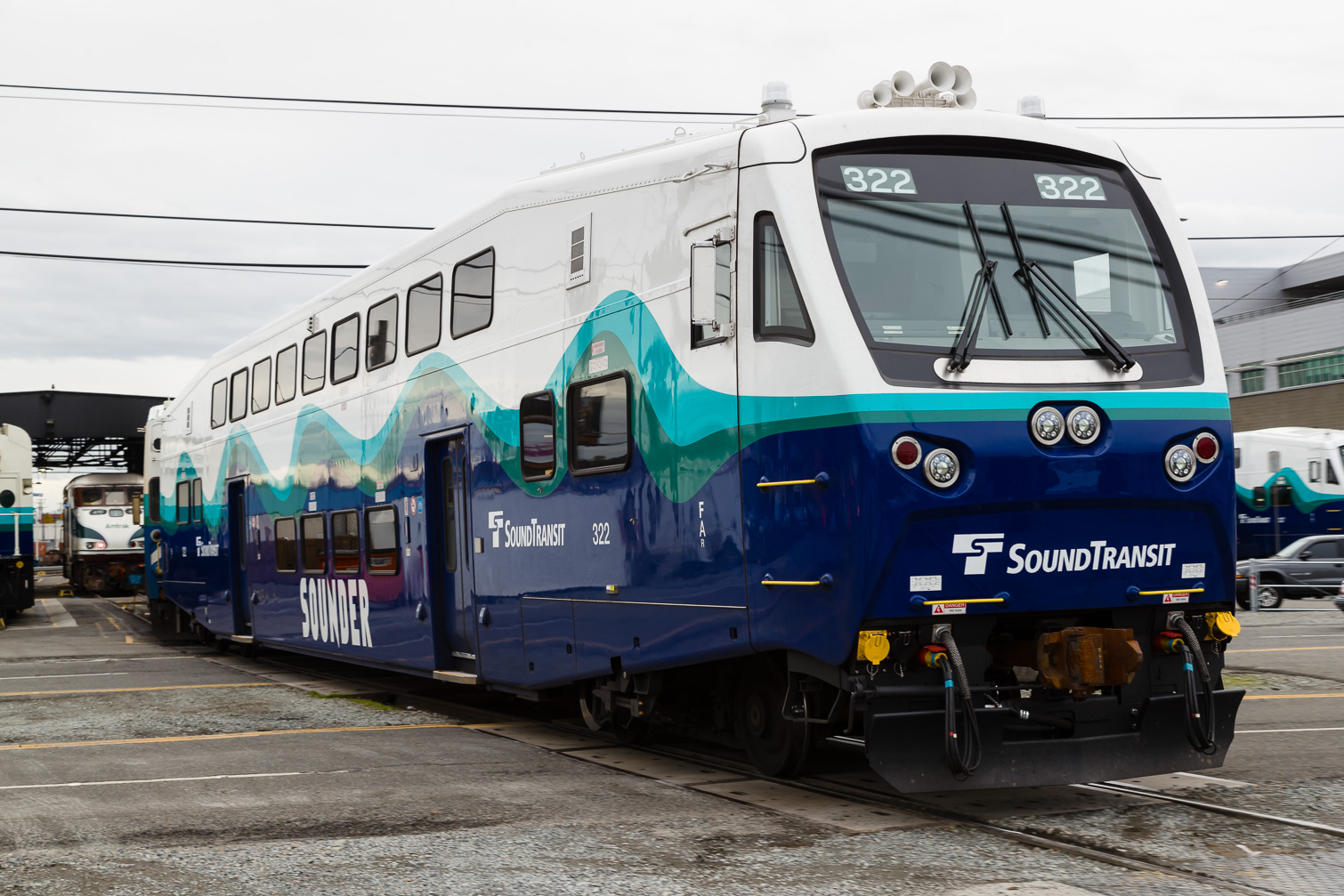 New locomotives are not the only new vehicles to have shown up in Seattle. Sound Transit runs the Sounder commuter rail service in the area and they have been taking delivery of new cab cars. These are built by Bombardier, as were the previous cab cars. However, this is a new design that incorporates crash energy management technology. As a result, they have done away with the passenger gangway on the front of the vehicle and provided a full width cab for the engineer. It provides a slightly more elegant front end to the vehicle than the previous design.
New locomotives are not the only new vehicles to have shown up in Seattle. Sound Transit runs the Sounder commuter rail service in the area and they have been taking delivery of new cab cars. These are built by Bombardier, as were the previous cab cars. However, this is a new design that incorporates crash energy management technology. As a result, they have done away with the passenger gangway on the front of the vehicle and provided a full width cab for the engineer. It provides a slightly more elegant front end to the vehicle than the previous design.
One More Chance With Virgin’s A340s
 Substitutions on the Seattle route are not just limited to Lufthansa. Virgin Atlantic has been flying the route with the 787-9 but, as with a lot of the Rolls Dreamliner operators, Virgin has been suffering from engine shortages while the blade cracking problems are dealt with. They have brought the A340-600 on to the route in the interim. I thought I wouldn’t be seeing these again after the last examples at SFO I saw but I got another chance. Not great light but it was good to see one more time.
Substitutions on the Seattle route are not just limited to Lufthansa. Virgin Atlantic has been flying the route with the 787-9 but, as with a lot of the Rolls Dreamliner operators, Virgin has been suffering from engine shortages while the blade cracking problems are dealt with. They have brought the A340-600 on to the route in the interim. I thought I wouldn’t be seeing these again after the last examples at SFO I saw but I got another chance. Not great light but it was good to see one more time.
F1 Engines (New and Used)
 I was too young to see a Saturn V launch. My one and only space launch has been a shuttle flight and that was very impressive. I can only imagine how cool the Saturn V was to witness. Maybe when the new generation of heavy launchers comes into service I will get to see something similar. The power for the first stage was provided by the F1 engines, five of which were clustered together. We made a trip to the Kennedy Space Center a long time ago and a Saturn V is on display there lying on its side. You can get face to face with the engine nozzles.
I was too young to see a Saturn V launch. My one and only space launch has been a shuttle flight and that was very impressive. I can only imagine how cool the Saturn V was to witness. Maybe when the new generation of heavy launchers comes into service I will get to see something similar. The power for the first stage was provided by the F1 engines, five of which were clustered together. We made a trip to the Kennedy Space Center a long time ago and a Saturn V is on display there lying on its side. You can get face to face with the engine nozzles.
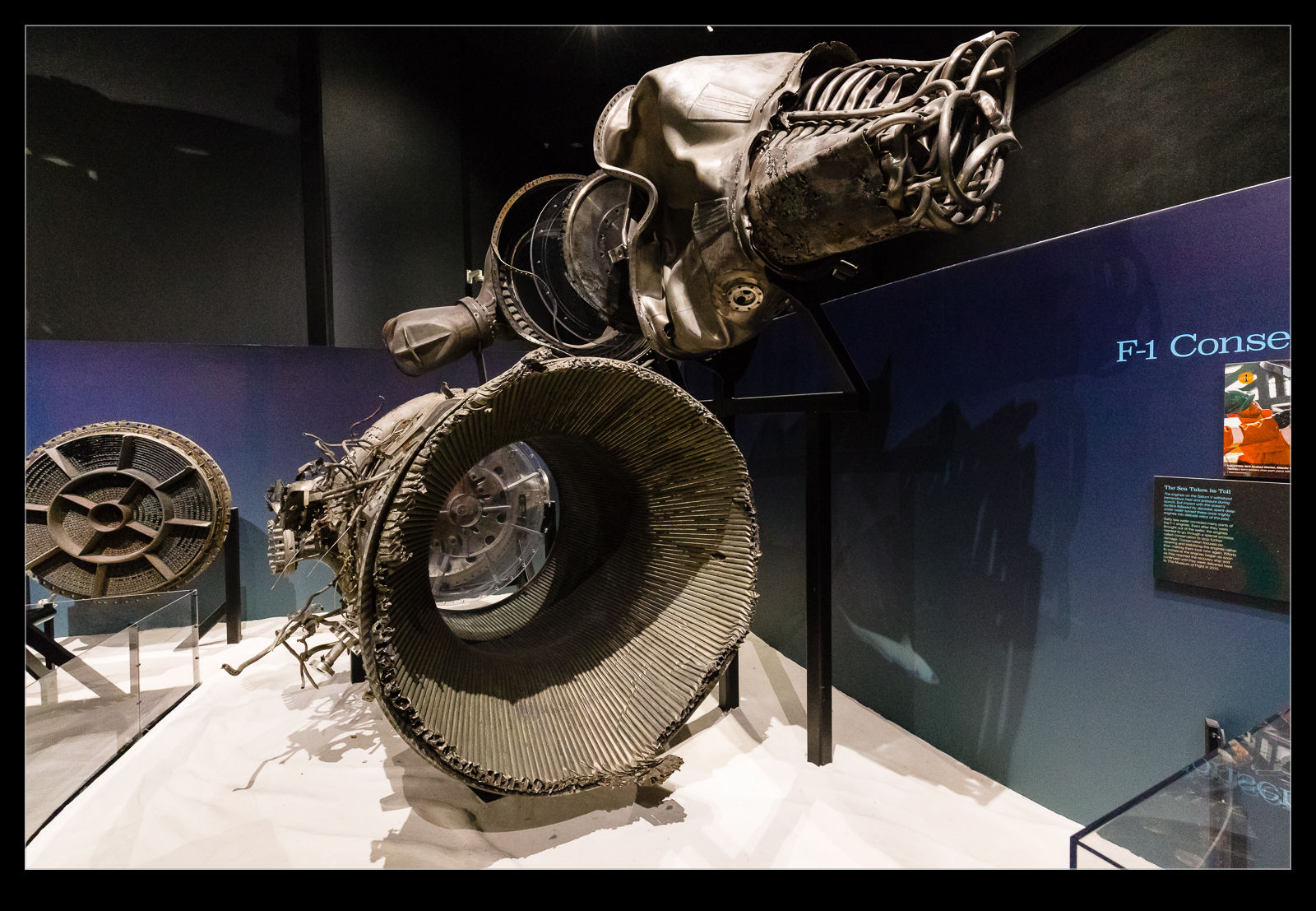 More recently, we checked out the Apollo exhibit at the Museum of Flight, here in Seattle. They have a display of an F1 engine but this one is not looking so pristine. This is because it is a used engine. Not just used as in test firing used but used as in flew on a mission, free fell to the ocean, hit the sea at speed, sank to the bottom of the Atlantic and stayed there for decades. Jeff Bezos, founder of Amazon, funded a project to recover the engines from Apollo 12.
More recently, we checked out the Apollo exhibit at the Museum of Flight, here in Seattle. They have a display of an F1 engine but this one is not looking so pristine. This is because it is a used engine. Not just used as in test firing used but used as in flew on a mission, free fell to the ocean, hit the sea at speed, sank to the bottom of the Atlantic and stayed there for decades. Jeff Bezos, founder of Amazon, funded a project to recover the engines from Apollo 12.
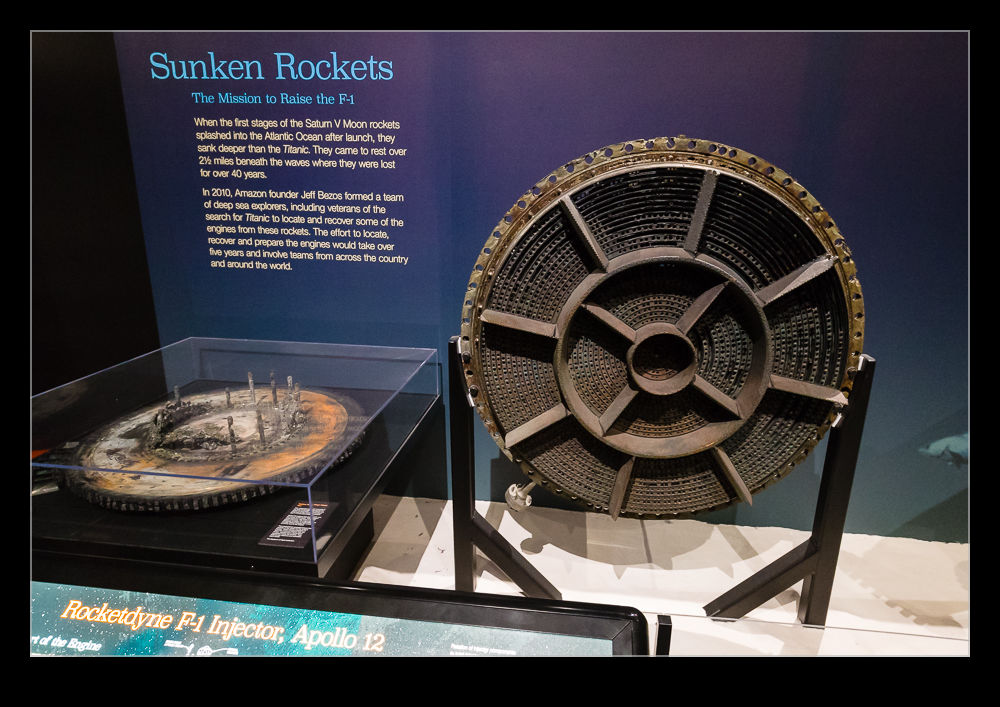 The nozzle is gone which is no surprise given how thin it is as you can see in the pictures of the undamaged version. However, the combustion chamber and the turbopump seem to have come through the experience in remarkable shape. The injector plate is also on display and has been pulled out of the assembly to show it off more clearly. The F1 was quite a feat of engineering – 1.5 million lbs of thrust and the pinnacle of 60s technology.
The nozzle is gone which is no surprise given how thin it is as you can see in the pictures of the undamaged version. However, the combustion chamber and the turbopump seem to have come through the experience in remarkable shape. The injector plate is also on display and has been pulled out of the assembly to show it off more clearly. The F1 was quite a feat of engineering – 1.5 million lbs of thrust and the pinnacle of 60s technology.
Two More 737s Heading to Renton
 At various times I have seen the fuselages for new Boeing 737s heading by on the trains through Seattle. Usually I am a distance away from them and I get a shot that is a bit hazy and less than distinct. Recently I was working in a yard alongside the main tracks as some equipment was being loaded. I had my camera to hand to record the loading process as a train came by behind us. Initially I figured it was just another freight train so didn’t pay attention. Then, I caught the color of the fuselages out of the corner of my eye and realized a couple of new jets were onboard. Before it got too much further, I was able to grab a couple of shots.
At various times I have seen the fuselages for new Boeing 737s heading by on the trains through Seattle. Usually I am a distance away from them and I get a shot that is a bit hazy and less than distinct. Recently I was working in a yard alongside the main tracks as some equipment was being loaded. I had my camera to hand to record the loading process as a train came by behind us. Initially I figured it was just another freight train so didn’t pay attention. Then, I caught the color of the fuselages out of the corner of my eye and realized a couple of new jets were onboard. Before it got too much further, I was able to grab a couple of shots.
New WSDOT Locomotives
 In the days running up to the introduction to service of the new WSDOT Siemens Charger locomotives, they were stored in the yard in Seattle awaiting the clearance to run. I was down there for another project and all of these shiny new locomotives were just asking to have their picture taken. How could I refuse? Sadly, one of these locos was involved in the accident a few weeks later.
In the days running up to the introduction to service of the new WSDOT Siemens Charger locomotives, they were stored in the yard in Seattle awaiting the clearance to run. I was down there for another project and all of these shiny new locomotives were just asking to have their picture taken. How could I refuse? Sadly, one of these locos was involved in the accident a few weeks later.
Lufthansa Retro Jet
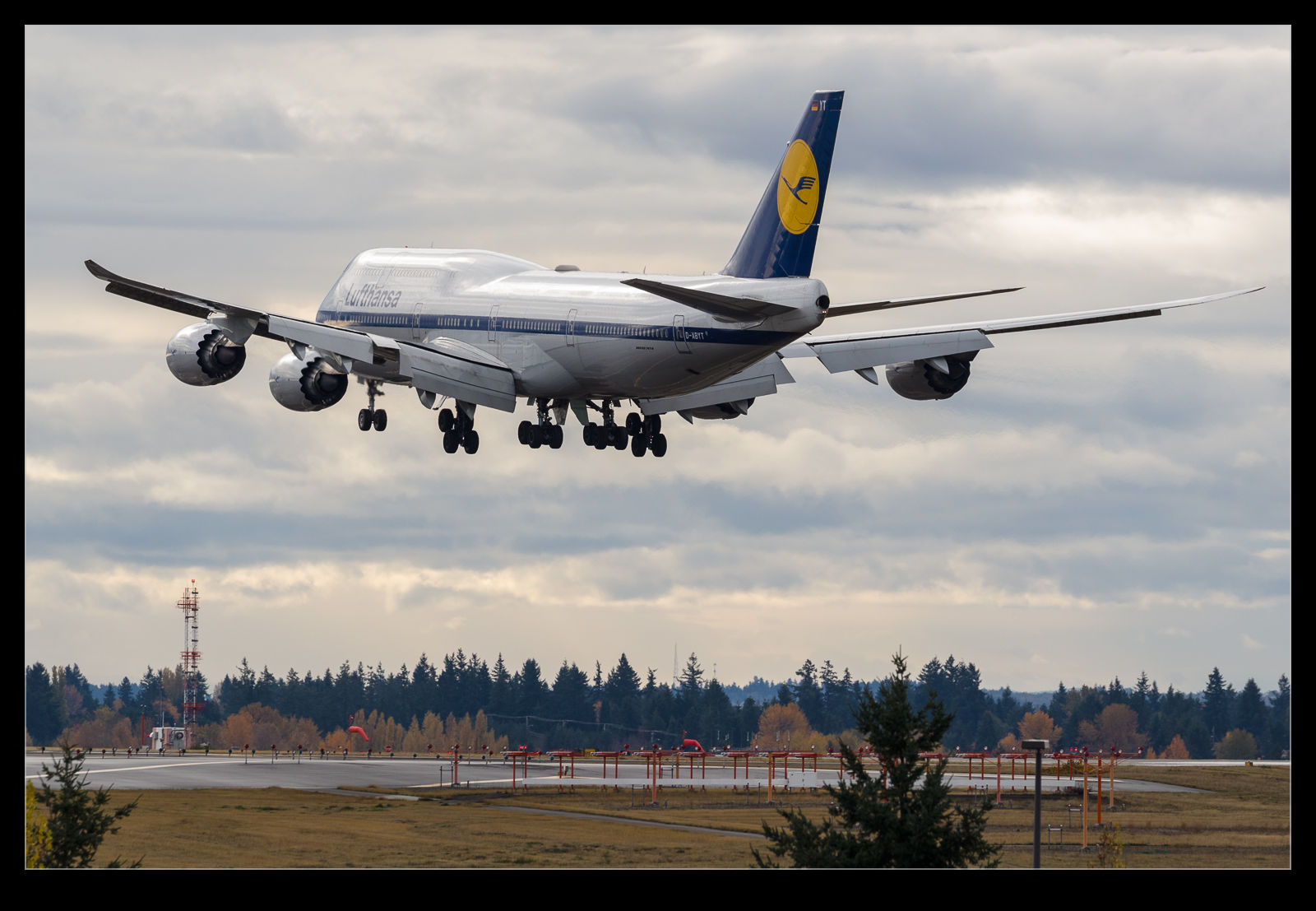 Lufthansa have painted up one of their 747-8I jets in a livery that is based on their old color scheme. Until recently, the Seattle route was being flown with a 747-400 so I didn’t anticipate the chance to see it. Then, in the aftermath of the Air Berlin bankruptcy, Lufthansa deployed some 747s on domestic services to bolster capacity. This meant some 747-400s were pulled from routes and the 747-8I was subbed on to Seattle. I was down there on a crummy day to get the IL-76 and the special jet was due in. I figured I couldn’t miss it, even if the conditions weren’t great. The light was not great as it came down the approach but the shot from behind as it got to the threshold was a bit better.
Lufthansa have painted up one of their 747-8I jets in a livery that is based on their old color scheme. Until recently, the Seattle route was being flown with a 747-400 so I didn’t anticipate the chance to see it. Then, in the aftermath of the Air Berlin bankruptcy, Lufthansa deployed some 747s on domestic services to bolster capacity. This meant some 747-400s were pulled from routes and the 747-8I was subbed on to Seattle. I was down there on a crummy day to get the IL-76 and the special jet was due in. I figured I couldn’t miss it, even if the conditions weren’t great. The light was not great as it came down the approach but the shot from behind as it got to the threshold was a bit better.
